Comparison of natural grassy ELM behavior in favorable/unfavorable Bt in EAST
Genfan DING (丁根凡),Qingquan YANG (杨清泉),Guosheng XU (徐国盛),Xin LIN (林新),Yang YE (叶扬),Ran CHEN (陈冉),Yumin WANG (王嵎民),Qing ZANG (臧庆),Heng LAN (兰恒),Liang CHEN (陈良),Zhikang LU (卢智康),Yifeng WANG (王一丰),Lingyi MENG (孟令义) and Liang WANG (王亮)
1 Anhui University,Hefei 230601,People’s Republic of China
2 Institute of Plasma Physics,Hefei Institutes of Physical Science,Chinese Academy of Sciences,Hefei 230031,People’s Republic of China
3 University of Science and Technology of China,Hefei 230026,People’s Republic of China
4 Institute of Energy,Hefei Comprehensive National Science Center,Hefei 230031,People’s Republic of China
Abstract The properties of grassy edge-localized modes (ELMs) in EAST in the favorable and unfavorable Bt are statistically studied.Statistical analysis indicates that there is no systematical difference in the frequencies of grassy ELMs under the two different magnetic configurations in the similar parameter spaces.The high-frequency grassy ELM(fELM>1 kHz)in unfavorable Bt is dependent on the high poloidal beta βp and high triangularity δu,while the high-frequency grassy ELM (fELM>1 kHz) in favorable Bt appears to rely on the high plasma density.A frequently occurring phenomenon in favorable Bt defined as ‘clustered ELM’ seems to be the most evident difference in ELM behavior between favorable and unfavorable Bt.Statistical analysis shows that larger plasma-wall outer gap,longer plasma elongation,lower low-hybrid wave heating power and electron cyclotron resonance heating power favor the occurrence of clustered grassy ELMs.Further studies indicate that the generation of clustered grassy ELMs could be correlated with the lower electron temperature in the bulk plasma.
Keywords: grassy ELM,favorable and unfavorable Bt,clustered ELM,EAST
1.Introduction
The high-confinement mode (H-mode) plasma,first found in the ASDEX tokamak in 1982,is characterized by the existence of an edge transport barrier,termed the ‘pedestal’ [1].The accompanying large-amplitude edge-localized modes(ELMs) in H-mode can cause quasi-periodic collapse of the pedestal and release more than 20% of the pedestal stored energy.The transient particle and heat fluxes induced by large ELMs would be transported to the divertor targets and the first wall,causing a significant risk of damage to plasma-facing components [2,3].To reduce the deleterious effects of large ELMs,significant efforts have been made in the development of ELM control methods [4–7] and intrinsic small/no ELM regimes [8–12].Among them,the grassy ELM regime is one of the promising regimes with natural small ELMs applicable to the steady-state operation of future fusion reactors[13,14],such as the Chinese Fusion Engineering Test Reactor(CFETR)[15,16].
In the past,the grassy ELM regime has been achieved in a series of tokamaks,such as JT-60U[12],JET[17],ASDEX Upgrade[18],DIII-D[19,20]and EAST[21,22].The EAST grassy ELM regime with ELM frequencyfELM>500 Hz can be achieved in a wide operational window with a high edge safety factorq95and poloidal beta βp[21].Compared to type-I ELM H-mode,the grassy ELM regime has displayed conspicuous advantages,such as tiny transient divertor peak heat flux,undetectable energy loss and strong capacity of the tungsten impurity exhaust.Moreover,small grassy ELMs exhibit good compatibility with the radiative divertor in EAST,offering a promising solution for the integrated control of transient and steady-state divertor heat flux in future fusion reactors [23,24].
In the past EAST experimental campaigns,grassy ELMs have been obtained in both favorable and unfavorable magnetic toroidal fields,Bt[21].In general,the direction of ion ∇Bdrift can greatly affect the tokamak plasma behavior.Most previous studies have focused on the effect of the ion∇Bdrift direction on the L-H transition power threshold[25–27] and divertor asymmetries [28–30].Recent investigations of the EAST tokamak also demonstrate that the ion∇Bdrift direction can greatly influence the scrape-off layer(SOL) density and thus plasma performance [31].Considering that plasma performance could have potential effects on the grassy ELM behavior,and that recent studies on the ASDEX Upgrade and TCV have indicated that edge density could affect the ELM behavior [32,33],we have therefore carefully compared the natural grassy ELM behavior in favorable/unfavorableBtin EAST.
The rest of this paper is organized as follows.The grassy ELM frequency and parameter space in favorable and unfavorableBtare carefully compared in section 2.Clustered grassy ELM,a frequently occurring phenomenon in favorableBt,is described in detail in section 3.Section 4 discusses the relationship between the plasma density and grassy ELM.Finally,a brief summary is given in section 5.
2.Comparison of grassy ELM frequency and parameter space in favorable/unfavorable Bt
2.1.Comparison of natural grassy ELM frequency
Considering that the amplitude of grassy ELM is quite difficult to evaluate using the available diagnostics in EAST [21]and generally small in both favorable and unfavorableBt,here we mainly focus on the grassy ELM frequencies under the two different magnetic configurations.A database of natural grassy ELM plasmas (without impurity injection,pellet injection,resonant magnetic perturbation and so on)has been established to systematically study the behavior of grassy ELM in frequency.The ELM frequency is calculated based on the divertorDαand edge extreme ultraviolet (XUV) systems.A peak inDαor the XUV signal represents an ELM burst.All theDαor XUV peaks (the number ofDαpeaksNpeaks~500–2000)are recognized in the steady-state phases(t~1–4 s),andfELM=Npeaks/tis the averaged ELM frequency of this time period.As shown in figure 1,all the grassy ELM H-mode plasmas included in the database are operated under the upper single null (USN) divertor configuration with favorable or unfavorableBt,and are in the parameter space of natural grassy ELMs,i.e.q95≥5.3,βp≥1.2 [21].It should be noted that the discharges withq95≥5.3,βp≥1.2,ELM frequencyfELM<500 Hz and heating power close to or lower than 1.5 times the L-H transition threshold power have been characterized as type-III ELMs,and thus have not been included in the database.
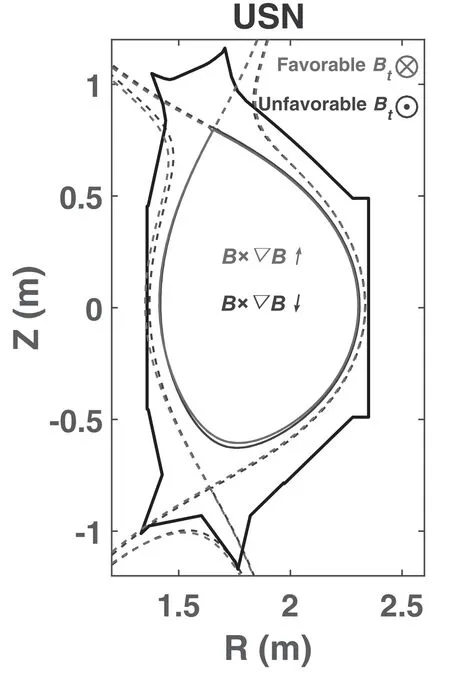
Figure 1.Magnetic configurations of favorable Bt( ∇B×B towards the active X-point) and unfavorable Bt ( ∇B×B away from the active X-point).
With assistance of the database,grassy ELM frequencies between the two different magnetic configurations are firstly compared in radio-frequency (RF)+neutral beam injection(NBI) heated H-mode.About 260 RF+NBI heated discharges(~130 of each magnetic configuration)with the same plasma currentIpand toroidal fieldBtvalue have been included,as shown in table 1.The ranges of the other two fundamental parameters,line-averaged densityneland total heating powerPtotal,are similar,and their averaged values,are also approximately similar.Note that the total heating powerPtotalis the sum of the ohmic power,lower hybrid wave (LHW),electron cyclotron resonance heating (ECRH),ion cyclotron resonance heating (ICRF) and NBI heating power.A statistical method,named the cumulativedistribution function (CDF),has been used to compare the ELM frequencies in the two different magnetic configurations.The CDF is defined as:F(m)=P(fELM≤m),i.e.the CDF value is the sum of probabilities thatfELM≤m.As shown in figure 2,the CDFs of ELM frequency in the two magnetic configurations are similar,indicating that there seems to be no significant difference in grassy ELM frequencies between the two different magnetic configurations under RF+NBI heating in the similar parameter space.

Table 1.Fundamental parameters of RF+NBI heated discharges in favorable and unfavorable Bt.
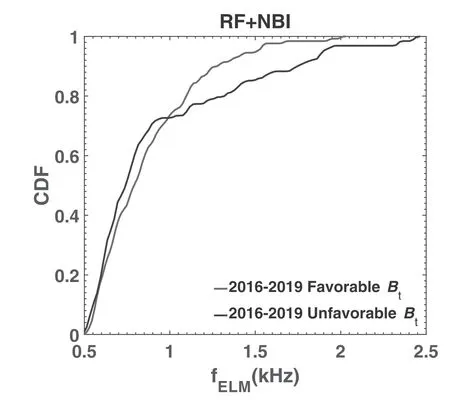
Figure 2.The CDF of grassy ELM frequency with RF+NBI heating in favorable and unfavorable Bt.
For a pure RF heating scheme,about 80 grassy ELM discharges (~40 of each magnetic configuration) could be included for comparison,and the fundamental parameters of these discharges are listed in table 2.Similar to the observations under RF+NBI heating,there seems to be no systematical difference in grassy ELM frequencies between the two different magnetic configurations under pure RF heating,as shown in figure 3(a).Note that the βpin favorableBtis systematically larger than that in unfavorableBtwith pure RF heating,as shown in figure 3(b).This is consistent with previous observations in EAST that the plasma performance in favorableBtis systematically higher than that in unfavorableBt[34].Nevertheless,the ELM frequencyfELMin favorableBtwith pure RF heating is not systematically higher than that in unfavorableBt.This is in contradiction with previous findings in EAST that higher βpfavors the occurrence of higher grassy ELM frequency[21].Considering that previous findings are mainly based on unfavorableBt,this contradiction further prompts us to find the difference in grassy ELM behavior between favorable and unfavorableBtand explore other potential parameters that affect grassy ELM frequency,especially in favorableBt.
2.2.Relationship between grassy ELM frequency and plasma density in favorable Bt
To find other potential parameters that could influence the grassy ELM frequency,apart from already-known βpand triangularity δu[21],we have conducted a series of comparisons in a broad space of fundamental parameters under favorable/unfavorableBt.In contrast to the aforementioned comparison,the database used here contains almost all the grassy ELM discharges without any parameter restrictions,and most of them are RF-heating dominated (PRF/Ptotal>60%).The most evident finding is the potential relationship between the grassy ELM frequency and the plasma lineaveraged densitynelin favorableBt.
In unfavorableBt,the occurrence of high-frequency grassy ELMs withfELM>1 kHz relies on high βpand high δu,as shown in figure 4.The dependence of high-frequency grassy ELM on high βpcan also be reflected by high heating power and a suitable density range,as shown in figure 5.The probable explanation is that the high heating power is beneficial for the access to high βp,and the suitable density range(nel≤4×1019m−3)is mainly required by maintaining good plasma heating and the current drive effect of the LHW.Note that previous analysis in EAST has indicated that the highest density for maintaining the moderate current drive effect of the LHW is up to 4.5×1019m−3in unfavorableBtunder the USN configuration in EAST [35].
In contrast,under favorableBt,there is no clear relationship between the occurrence of high-frequency grassy ELMs and βpor δu,as shown in figure 4.Unlike the unfavorableBtcase,the dependence on high heating power cannot be observed for high-frequency grassy ELM under favorableBtas well.Notably,the high-frequency grassy ELMs(fELM>1 kHz) are mostly operated in the higher density range ofnel~(4–6)×1019m−3in favorableBt.These results imply that the occurrence of high-frequency grassy ELM(fELM>1 kHz) in favorableBtcould be more dependent on the high line-averaged plasma density rather than high-βpor high-δuin EAST.This topic will be further discussed in section 4.
2.3.Comparison in parameter spaces of grassy ELM regime in favorable/unfavorable Bt
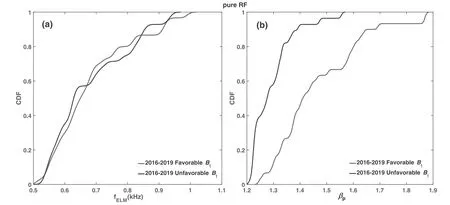
Figure 3.The CDF of (a) grassy ELM frequency and (b) poloidal beta βp with pure RF heating in favorable and unfavorable Bt.
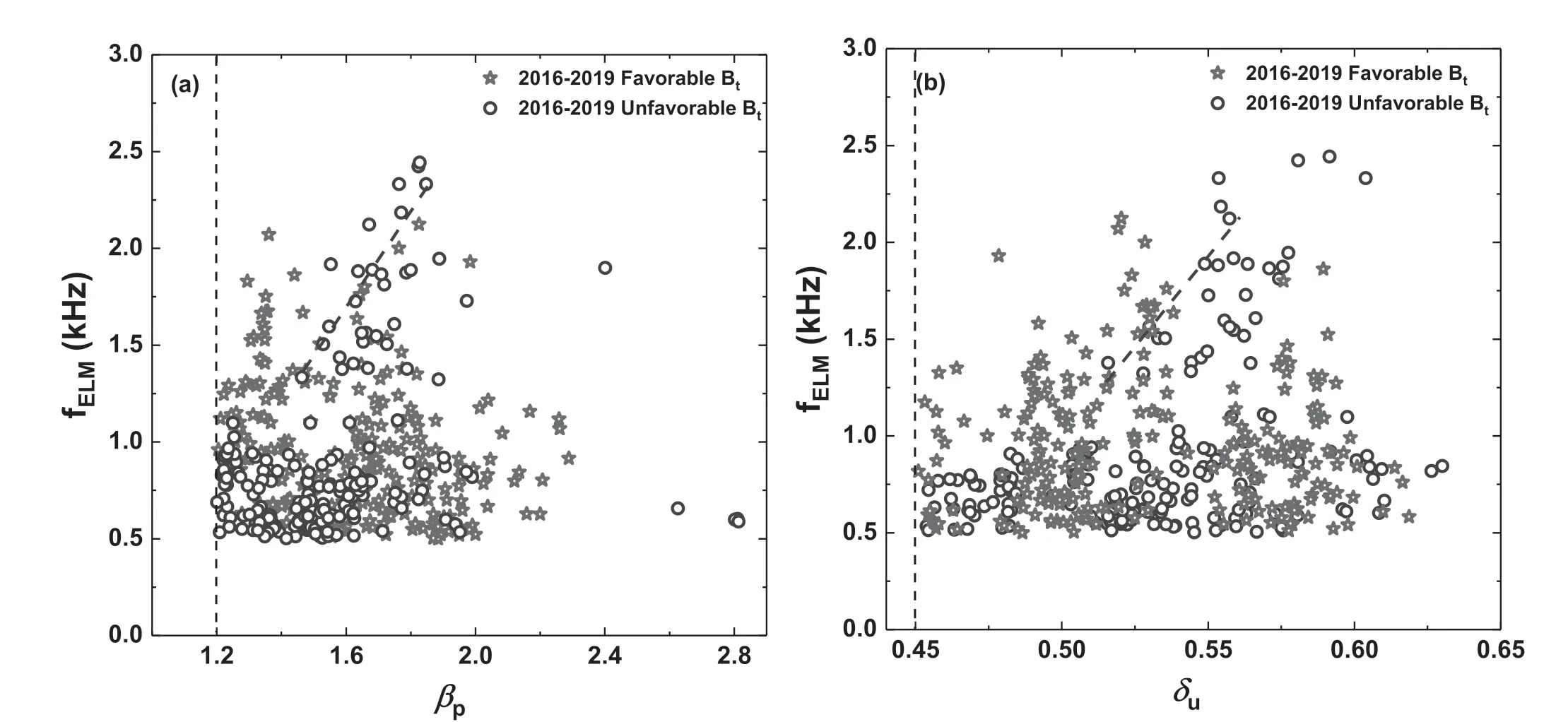
Figure 4.ELM frequency as functions of (a) poloidal beta βp and (b) plasma upper triangularity δu for EAST grassy ELM discharges in favorable and unfavorable Bt.

Table 2.Fundamental parameters of pure RF-heated discharges in favorable and unfavorable Bt.
Previous analysis has indicated that the grassy ELMs withfELM>500 Hz are highly reproducible in a wide parameter space in EAST when the requirements of highq95≥5.3 and βp≥1.2 are simultaneously satisfied [21].The other two crucial requirements for the achievement of grassy ELMs in other tokamaks,high internal inductancelior triangularity,cannot be clearly observed in EAST,while higher triangularity could favor the increase in grassy ELM frequency.Considering that previous analysis of grassy ELM parameter space[21]has not clearly distinguished favorable or unfavorableBtconfigurations,we will focus on this topic in this section.
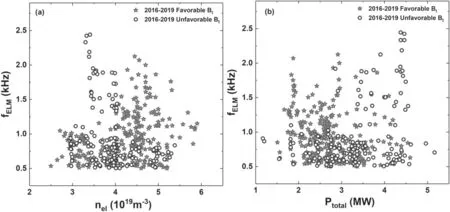
Figure 5.ELM frequency as functions of(a)line-averaged density nel and(b)the total heating power Ptotal for EAST grassy ELM discharges in favorable and unfavorable Bt.
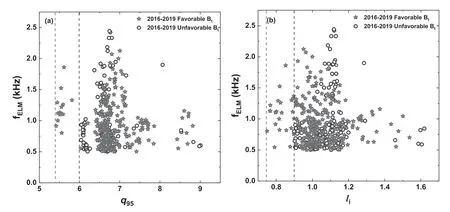
Figure 6.ELM frequency as functions of (a) the edge safety factor q95 and (b) internal inductance li for EAST grassy ELM discharges in favorable Bt and unfavorable Bt.
The operational spaces ofq95andlishow evident differences for the access to the grassy ELM regime in the two different magnetic configurations,as shown in figure 6.Here,q95≥5.3 should be satisfied for access to the grassy ELM regime in the favorableBtconfiguration,while for the unfavorableBtconfiguration it isq95≥6.This may be due to the fact that a higher βpis more easily achieved at relatively lowq95under favorableBtwith better performance.In the future,more explorations will be conducted towards lowerq95(~4–5) in both favorable and unfavorableBtwith more available heating power in EAST.Thelispace,for access to the grassy ELM regime in the favorableBtconfiguration,has also been demonstrated to be wider than that in the unfavorableBtconfiguration,i.e.li≥0.75 in favorableBtandli≥0.9 in unfavorableBt.This could also be due to the better performance in favorableBt,where high βpcould be achieved with less LHW or ECRH heating power.In addition,as shown in figures 4 and 5,the operational spaces ofnel,βpand δushow no significant differences for the access to the grassy ELM regime in the two different magnetic configurations.
3.Clustered grassy ELMs in favorable Bt
3.1.Typical clustered grassy ELMs
Clustered grassy ELM,frequently occurring in favorableBt,is the most evident difference in ELM behavior between favorable and unfavorableBtin EAST.Figure 7(a) shows a typical clustered grassy ELM discharge #85352 withq95~6.8,nel~4.06×1019m−3andPtotal~2.6 MW in the favorableBtconfiguration.It is worth noting that each spike in the cluster should be a burst of ELM,rather than ELM filaments.For instance,the large ELM filaments can also be detected by divertorDαemissions sometimes,as shown in figure 7(d).Whereas,unlike the quick and sharp drop in theDαsignal in the single ELM burst in figure 7(a),theDαsignal during the burst of the single ELM filament cannot quickly drop to the baseline level.Moreover,as shown in figure 7(e),the single filament cannot be detected by the XUV measurement as well.Even though the magnetic fluctuations of type-I ELM filaments can be detected by magnetic pick-up coils sometimes,the main difference is that their global perturbations cannot quickly recover to steady-state,as shown in figure 7(f).
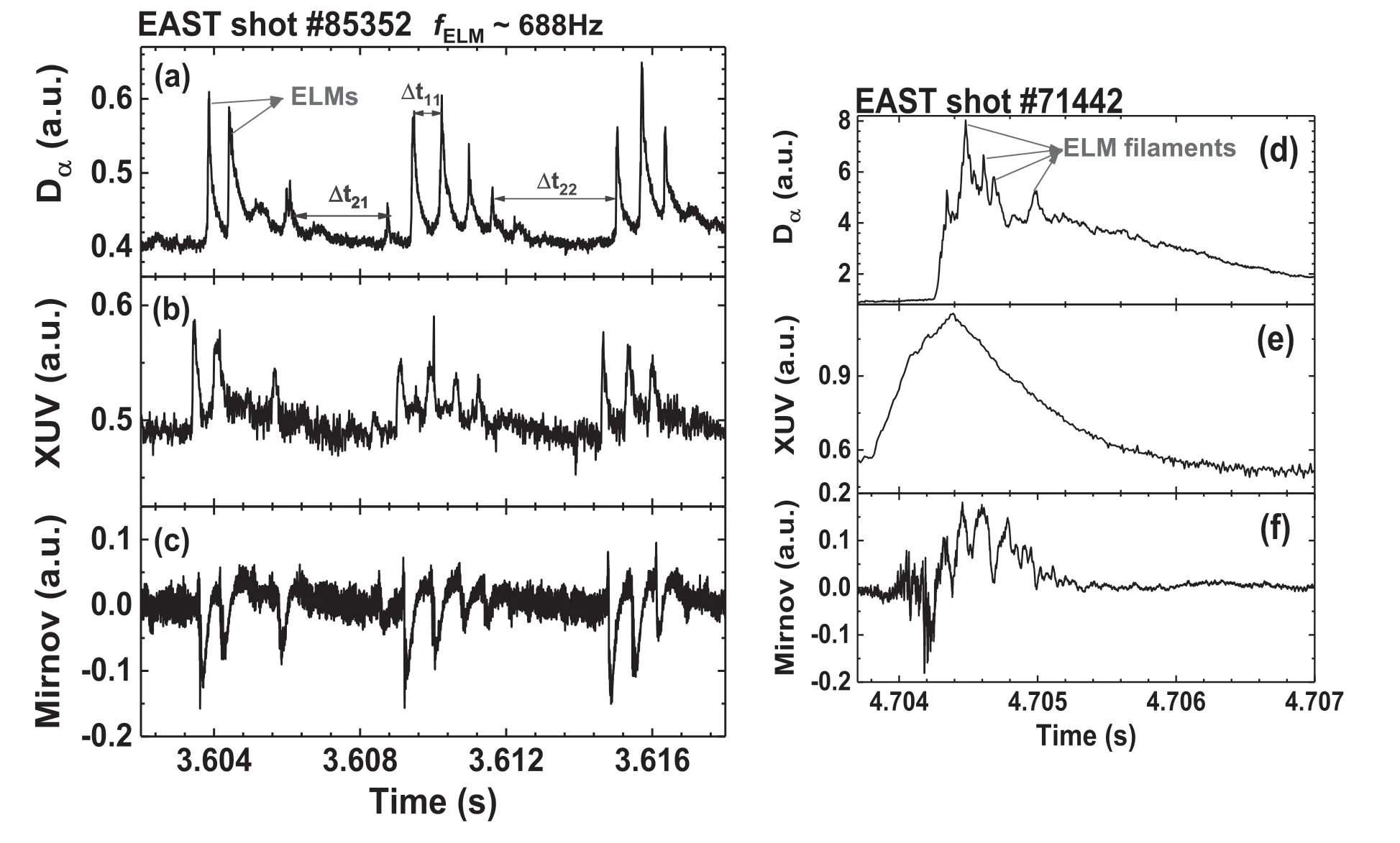
Figure 7.Typical clustered grassy ELM measured by(a)divertor Dα emission,(b)XUV radiation and(c)Mirnov coil systems.Filaments of large ELM measured by (d) divertor Dα emission,(e) XUV radiation and (f) Mirnov coil systems.

Figure 8.ELM frequency as a function of R for grassy ELM discharges in favorable Bt and unfavorable Bt,where
To better understand the phenomenon of clustered grassy ELM,a ratioR has been defined asR=t2/t1,where Δt2is the time interval between adjacent ELM larger than 1/fELM,andt2is the averaged value of Δt2.Here,Δt1is the time interval between adjacent ELM less than 1/fELM,andt1is the averaged value of Δt1.As shown in figure 7(a),the ELM frequency that we calculated here is the averaged ELM frequencyfELM~688 Hz,Δt21,Δt22,Δt23,… Δt2nare larger than 1/fELM~0.0015 s,t2=(Δt21+Δt22+ Δt23+…+Δt2n)/n.Here,Δt11,Δt12,Δt13,… Δt1mare smaller than 0.0015 s,=(Δt11+Δt12+Δt13+…+Δt1m)/m,and we finally get the ratioR =t2/t1.According to the above definition,a higherR means that grassy ELMs are more evident as clustered ELMs.Combining the defined ratio with the experimental observations,it can be found that the grassy ELMs withR<4 may occasionally show a certain degree of cluster.But most of the typical clustered ELMs are the grassy ELMs withR larger than 4.Therefore,we define the grassy ELM withR > 4 as typical ‘clustered ELM’,and the grassy ELM with Figure 9.The ratio R versus (a) outer gap,(b) elongation κ and (c) upper triangularity δu for clustered and non-clustered grassy ELMs in favorable Bt.CDFs of (d) outer gap,(e) elongation κ and (f) upper triangularity δu. Considering that there are a large number of non-clustered ELMs in favorableBt,there should be other parameters that could affect the occurrence of clustered grassy ELMs.The relationship between the occurrence of clustered grassy ELMs and plasma configuration parameters has firstly been investigated here.As shown in figures 9(a),(d) and (b),(e),the occurrence of clustered grassy ELMs shows a strong correlation with a large plasma outer gap (distance between the separatrix and limiter) and high plasma elongation κ.But for upper triangularity δu,there is no evident correlation between the occurrence of clustered grassy ELMs and δu.It is suggested that an elongated plasma with a large outer gap seems to facilitate the occurrence of clustered grassy ELMs in favorableBt. In addition to the configuration,we find that lower electron heating power is important for the occurrence of clustered grassy ELMs.Figure 10 shows the comparisons ofPLHW,PECRHandPtotalfor clustered and non-clustered grassy ELMs in favorableBt.It can be found that most of the clustered grassy ELM discharges are operated with relatively lower LHW and ECRH heating power compared with non-clustered grassy ELM discharges,as shown in figures 10(a),(d) and(b),(e).Nevertheless,as shown in figures 10(c) and (f),the total heating power of clustered and non-clustered grassy ELM discharges shows no significant difference.These results imply that it is the lower electron heating power rather than the total heating power that favors the occurrence of the clustered grassy ELMs. Figure 10.The ratio R versus(a)ECRH,(b)LHW and(c)total heating power for clustered and non-clustered grassy ELMs in favorable Bt.CDFs of (d) ECRH,(e) LHW and (f) total heating power for clustered and non-clustered grassy ELMs. Figure 11.The ratios R of clustered and non-clustered grassy ELMs in favorable and unfavorable Bt versus(a)core(ρ~0.1–0.2)electron temperature and (b) pedestal top (ρ~0.8–0.9) electron temperature. The lower LHW and ECRH heating power implies that the occurrence of the clustered grassy ELMs could be correlated with lower electron temperature in the bulk plasma.Figure 11 compares the electron temperature measured by Thomson Scattering (TS) diagnostic between clustered and non-clustered grassy ELM discharges in the plasma core(ρ~0.1–0.2) and near pedestal top (ρ~0.8–0.9).It demonstrates that both the core and pedestal top electron temperatures of clustered grassy ELM discharges are evidently lower than those of non-clustered grassy ELM discharges in either favorable or unfavorableBt.Furthermore,the defined cluster parameterR shows a clear decreased downtrend with increasing electron temperature either in the core or near the pedestal top,indicating that the generation of clustered grassy ELM could be directly correlated with the lower electron temperature in the bulk plasma.Moreover,as shown in figure 11(b),without LHW heating power,the pedestal top temperature measured by the electron cyclotron emission system is all concentrated in the low temperature range with the large cluster degreeR. Figure 12.ELM frequency as functions of (a) separatrix density ne,sep and (b) pedestal top density ne,ped. Note that there are two clustered ELM discharges with R > 4 in unfavorableBt,as shown in figure 8.The core temperatures of these two discharges are 2.63 keV and 2.24 keV,respectively,and the pedestal temperatures of these two discharges are 0.39 keV and 0.34 keV,respectively,which are also relatively low,as shown in figure 11.This further illustrates that the lower electron temperature is the key factor for the occurrence of clustered ELMs. Separatrix density is important for the occurrence of small ELM in the ASDEX Upgrade and TCV [32,33].In EAST,we have also observed that high-frequency grassy ELMs(fELM>1 kHz) in favorableBtshow a strong correlation with high line-averaged plasma density.Therefore,it is of high importance to investigate the correlation between separatrix density and the occurrence of high-frequency grassy ELMs in EAST.The separatrix and pedestal top densities of grassy ELM discharges measured by microwave reflectometry in favorableBtare shown in figure 12.The separatrix densities of high-frequency grassy ELMs are concentrated in the high density range,while the pedestal top densities of high-frequency grassy ELMs discretely distribute in a wide density range.Therefore,it seems that high separatrix density could be an important factor for the achievement of high-frequency grassy ELMs in favorableBtin EAST.Nevertheless,considering the location uncertainties for microwave reflectometer measurement [36],more dedicated and detailed experiments still need to be completed to validate this conclusion. In addition to the relationship between separatrix density and high-frequency grassy ELMs in favorableBt,the potential relationship between plasma density and clustered ELMs shown in this paper should be addressed.As shown in figure 13(a),the clustered ELMs appear in a wide plasma density range,i.e.nel~(3.2–5.5)×1019m−3.The cumulative distribution function shown in figure 13(b) indicates that the line-averaged plasma density for clustered ELMs is relatively higher than that for non-clustered ELMs.Nevertheless,unlike the analysis in the plasma temperature case,there are still large numbers of non-clustered ELMs at high plasma density in favorableBthere.Therefore,it seems that the appearance of clustered ELMs relies more on plasma temperature compared with plasma density.Moreover,as shown in figure 14,the separatrix and pedestal top densities show no significant differences between clustered and non-clustered ELMs.This further indicates that the occurrence of clustered ELMs depends more on plasma temperature than on plasma density.Note that due to the remarkably lower electron temperature,the pedestal pressure of clustered ELMs is systematically lower than that of non-clustered ELMs,and the pedestal collisionality of clustered ELMs is significantly higher than that of non-clustered ELMs. One possible reason for the concentrated occurrence of clustered ELMs in favorableBtcould be that it is much easier to achieve grassy ELMs with limited RF heating in favorableBtup to now.Previous analysis [31] has also indicated that more neutral particles will penetrate deeper into the pedestal region and provide higher fuelling for the pedestal,and thus the pedestal density gradient will increase and then the radial electric field shear could be larger in the favorableBt.The higher pedestal density is beneficial for the NBI heating and the larger radial electric field shear could reduce the edge turbulence intensity,and thus the high-performance grassy ELMs can be achieved with less RF heating power.Actually,a grassy ELM with the absence of LHW power could only be observed in favorableBtin EAST,and the grassy ELM does appear to be clustered there.Note that the EAST counter-NBI system is planned to switch to co-current injection,and this could facilitate the exploration of grassy ELM operation with limited or even no RF heating in unfavorableBt.The relevant experiment is under schedule and more attention will be paid to the physics nature and mechanism of clustered ELM in the near future. Figure 13.The ratios R of clustered and non-clustered grassy ELMs in favorable Bt versus (a) line-averaged density and (b) CDFs of lineaveraged density. Figure 14.The ratios R of clustered and non-clustered grassy ELMs in favorable Bt versus(a)separatrix density and(b)pedestal top density. In summary,the natural grassy ELM behavior in favorable/unfavorableBtin EAST has been studied.Statistical analysis indicates that the frequency of grassy ELM shows no significant differences between the two different magnetic configurations in similar parameter spaces.In favorableBt,high-frequency grassy ELMs (fELM>1 kHz) seem to be more dependent on the high line-averaged plasma density rather than high βpor high triangularity δ.Furthermore,comparisons in the parameter spaces of the grassy ELM regime in favorable/unfavorableBtindicate that the operational spaces of βpand δuare similar for the two different magnetic configurations,while the operational spaces ofq95andliin favorableBtare relatively wider than those in unfavorableBt. Clustered ELM is a more frequently occurring phenomenon in favorableBt.Detailed analysis indicates that an elongated plasma with a large outer gap and lower electron heating power seems to facilitate the occurrence of clustered grassy ELMs in favorableBt.Further studies demonstrate that the generation of clustered grassy ELMs could be directly correlated with the lower electron temperature in the bulk plasma.In general,the experimental findings in this work could offer more insights into the mechanism behind grassy ELMs and might be helpful for further exploration of the grassy ELM regime in EAST. Acknowledgments This work was supported by the National Magnetic Confinement Fusion Energy R&D Program of China (No.2017YFE0301300); National Natural Science Foundation of China (Nos.12005257 and 11905143); the Key Research Program of Frontier Sciences,the CASHIPS Director’s Fund(No.YZJJ2020QN13); Special Research Assistant Funding of CAS and China Postdoctoral Science Foundation (No.2020M671913).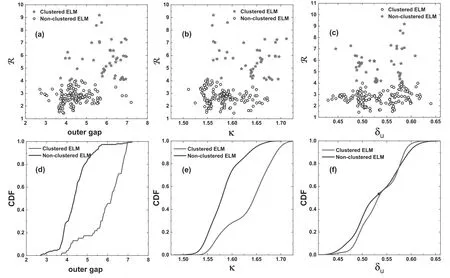
3.2.Relationship between the occurrence of clustered grassy ELMs and plasma configuration parameters
3.3.Relationship between the occurrence of clustered grassy ELMs and plasma heating power
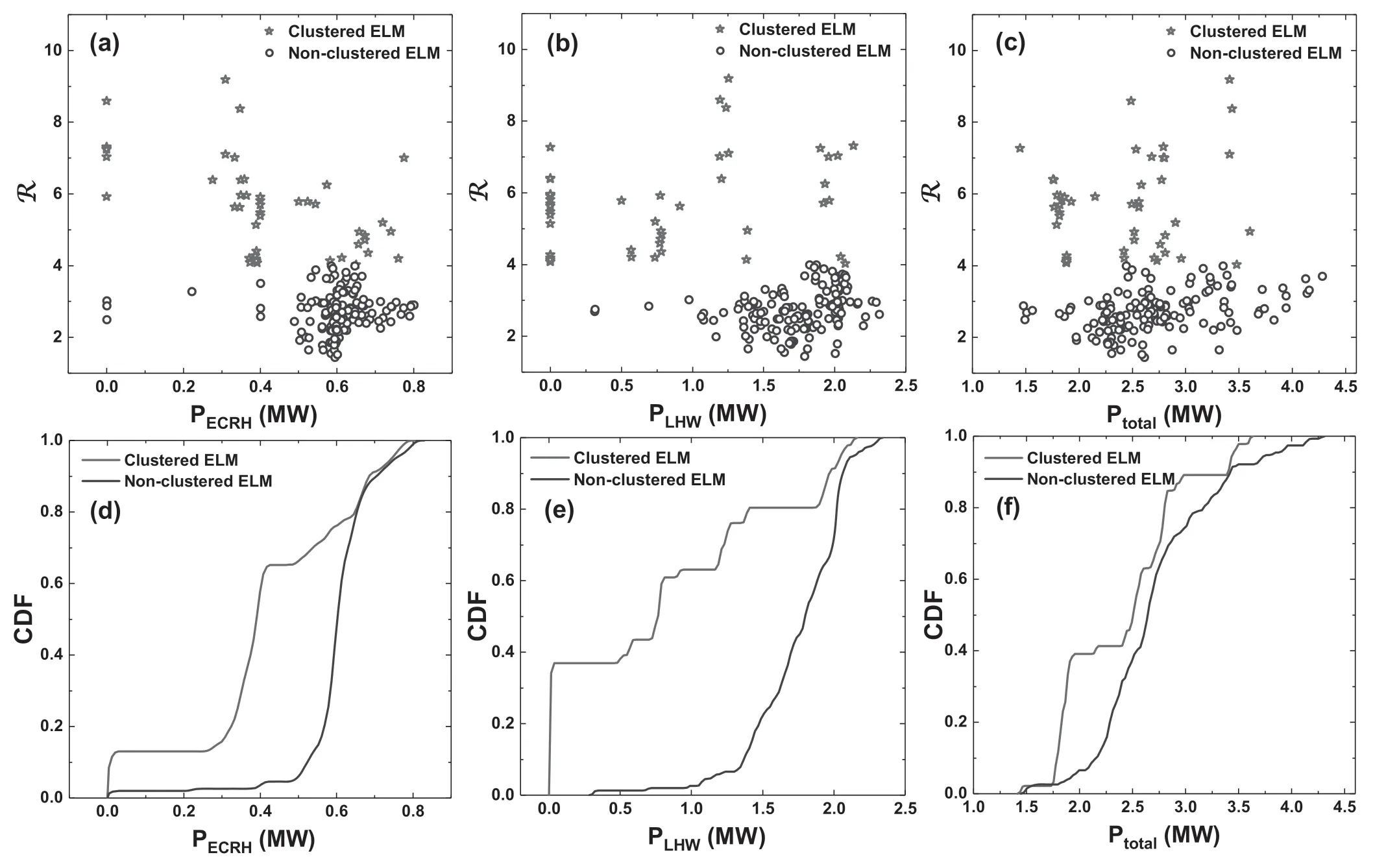
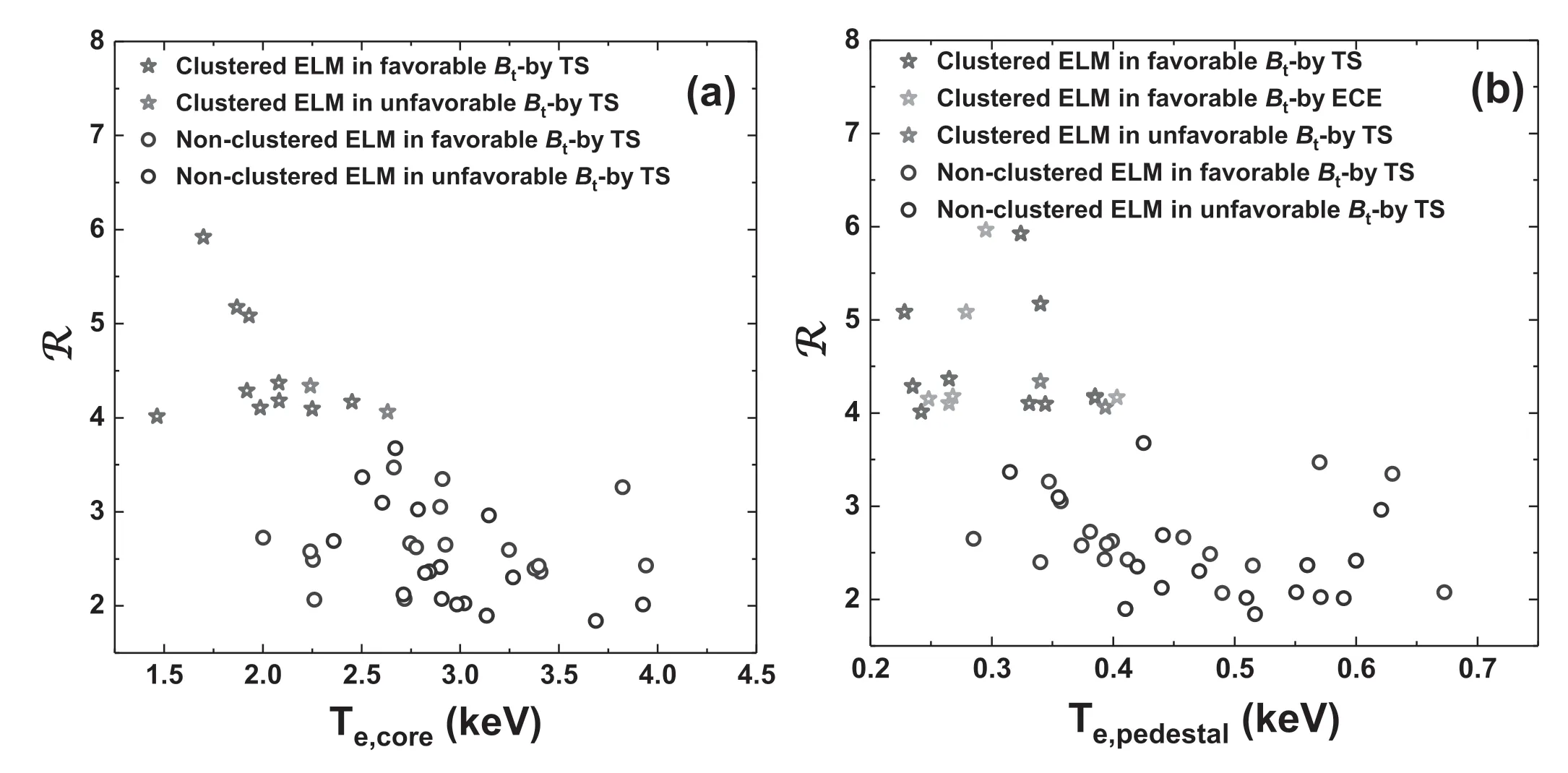
3.4.Relationship between the occurrence of clustered grassy ELMs and lower electron temperature
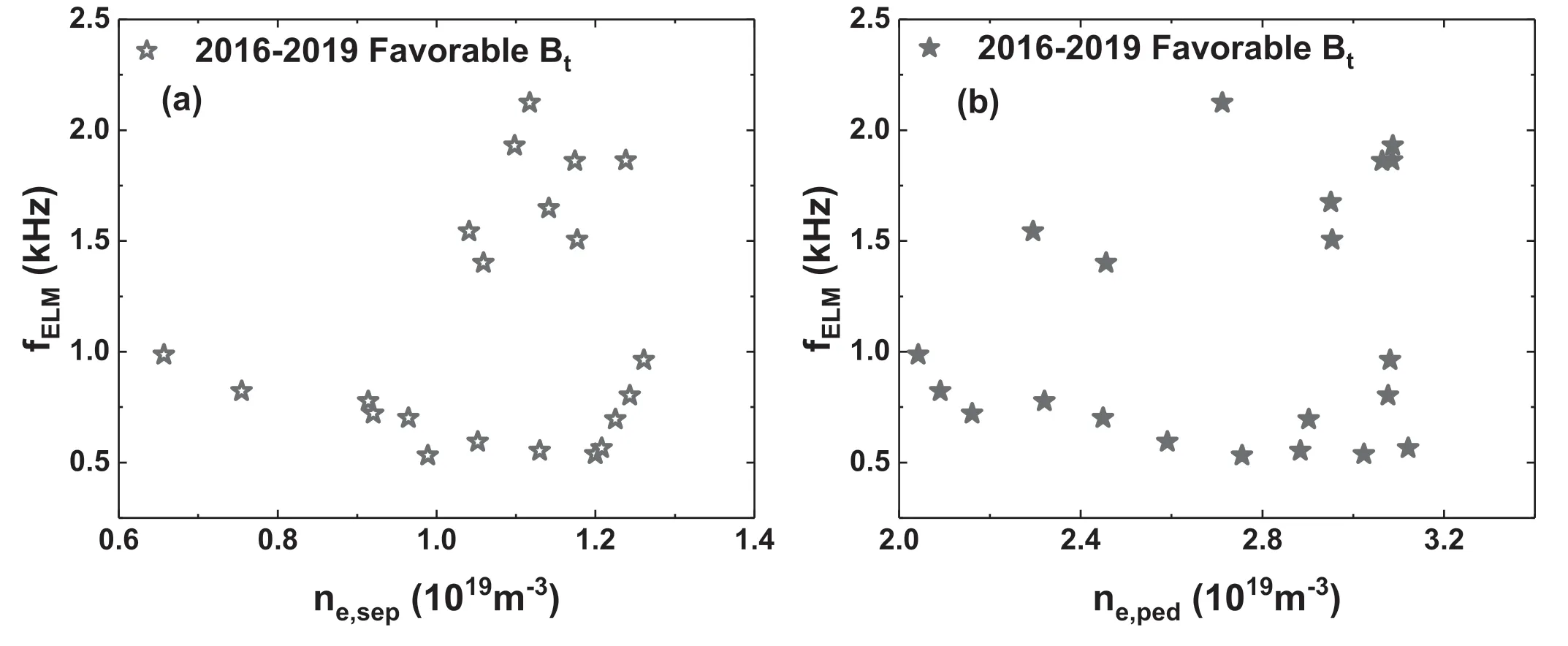
4.Discussion
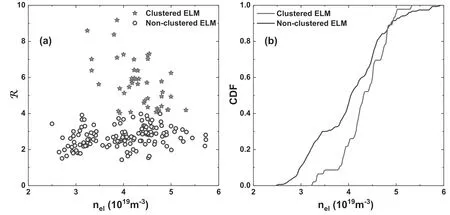
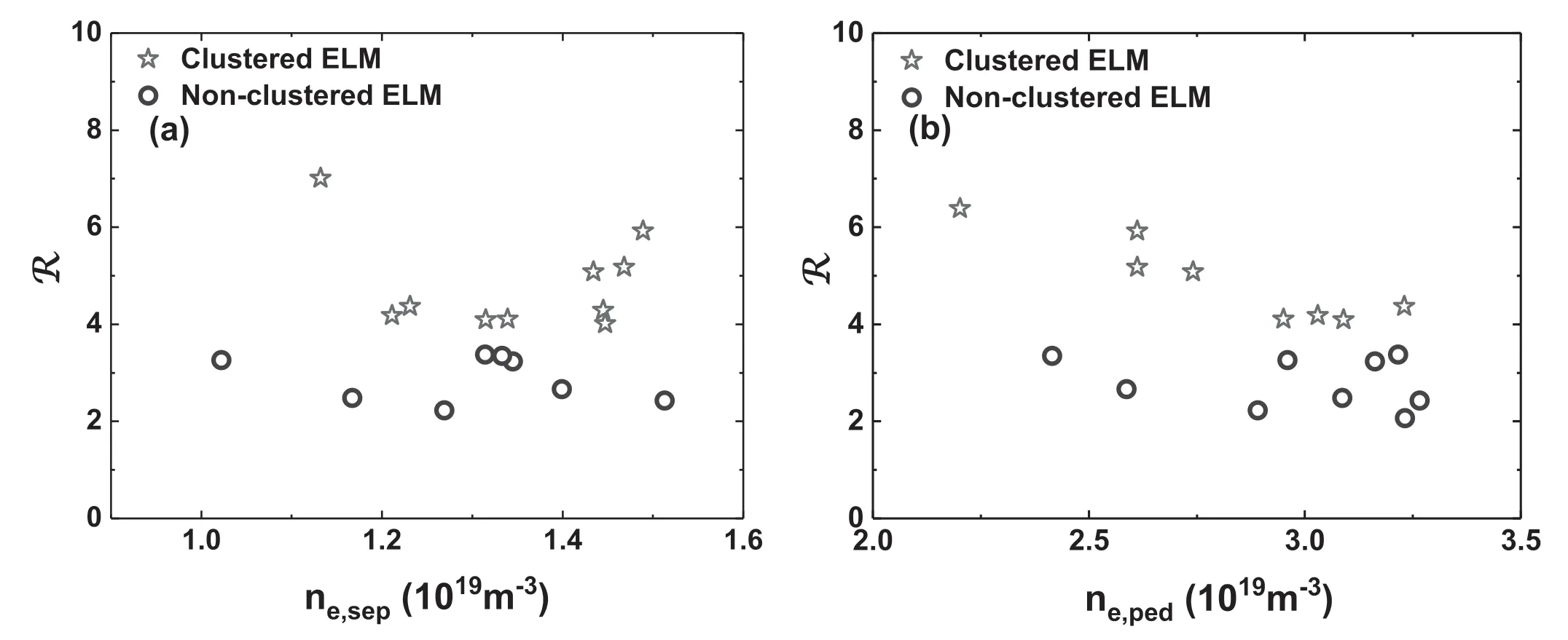
5.Summary
 Plasma Science and Technology2021年9期
Plasma Science and Technology2021年9期
- Plasma Science and Technology的其它文章
- Recent results of fusion triple product on EAST tokamak
- Suppression and mitigation of inter-ELM high-frequency Alfvén-like mode by resonant magnetic perturbation in EAST
- Simulations of NBI fast ion loss in the presence of toroidal field ripple on EAST
- Reconstructions of velocity distributions from fast-ion D-alpha (FIDA) measurements on EAST
- Tomography of emissivity for Doppler coherence imaging spectroscopy diagnostic in HL-2A
- The investigation of quasi coherent mode on EAST using Doppler reflectometry
